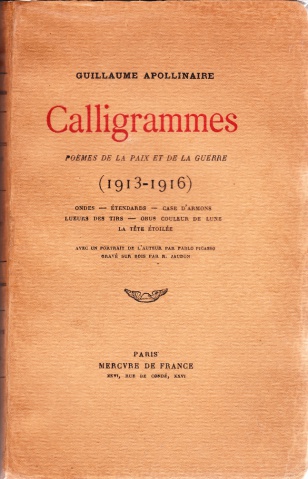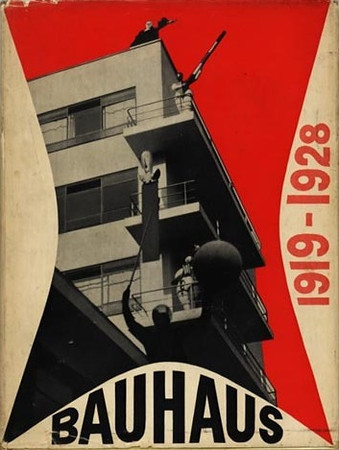Guillaume Apollinaire: Calligrammes: Poems of Peace and War, 1913–1916 (1918–) [FR, CZ, RU, EN, ES]
Filed under poetry | Tags: · concrete poetry, poetry, typography, visual poetry

Calligrammes is a key work not only in Apollinaire’s own development but in the evolution of modern French poetry. Apollinaire–Roman by birth, Polish by name (Wilhelm-Apollinaris de Kostrowitski), Parisian by choice–died at thirty-eight in 1918. Nevertheless, he became one of the leading figures in twentieth-century poetry, a transitional figure whose work at once echoes the Symbolists and anticipates the work of the Surrealists.
Apollinaire described calligrams as “an idealisation of free verse poetry and typographical precision in an era when typography is reaching a brilliant end to its career, at the dawn of the new means of reproduction that are the cinema and the phonograph.” (from a letter to André Billy, quoted in a preface to the 1966 French edition by Michel Butor)
French edition
With a portrait of the author by Pablo Picasso
Publisher Mercvre de France, Paris, 1918
205 pages
English/French bilingual edition
Translated by Anne Hyde Greet
With an Introduction by S.I. Lockerbie
Commentary by Anne Hyde Greet and S.I. Lockerbie
Publisher University of California Press, 1980
ISBN 0520242122, 9780520242128
513 pages
Apollinaire in UbuWeb Sound
Wikipedia (EN)
Publisher (EN)
Calligrammes, poèmes de la paix et de la guerre 1913-1916 (via Gallica.BNF.fr)
Kaligramy (Czech, trans. Karel and Miloslav Baláš, 1948, incomplete)
Stikhi (includes “Kalligrammy”, pp 99-150, Russian, trans. M. Koudinov, 1967, DJVU)
Calligrammes: Poems of Peace and War (1913-1916) (English/French, trans. Anne Hyde Greet, 1980, from UbuWeb)
Kalligrammy. Stikhotvoreniya mira i voyny 1913-1916 (Russian, 1999, TXT)
Caligramas: Poemas de la paz y de la guerra (1913-1916) (Spanish, trans. José Ignacio Velazquez, 1987, selection)
Idéogrammes (Spanish translation of Et moi aussi je suis peintre by Jorge Segovia, 2012)
Herbert Bayer, Walter Gropius, Ise Gropius (eds.): Bauhaus 1919–1928 (1938)
Filed under book, catalogue | Tags: · 1920s, architecture, art, art history, avant-garde, bauhaus, design, graphic design, industrial design, painting, photography, sculpture, typography


Bauhaus 1919-1928 remains one of the most valuable accounts of the Bauhaus school. The book was published in conjunction with the Museum Of Modern Art exhibition (December 7, 1938-January 30, 1939) and is a point-for-point record of actual programs and projects at the Bauhaus, prepared by Herbert Bayer under the general editorship of Walter Gropius and Ise Gropius and with the collaboration of a dozen other Bauhaus teachers — including Kandinsky, Klee, Feininger, Schlemmer, Itten, Moholy-Nagy, Albers, and Breuer. Rather than a retrospective history, it is a collection of photographs, articles, and notes prepared on the field of action. It may be considered as much a work of the Bauhaus as it is a work about it.
Includes work by all the Bauhaus faculty including Walter Gropius, Paul Klee, Wassily Kandinsky, Laszlo Moholy-Nagy, Marcel Breuer, Herbert Bayer, Josef Albers, Lyonel Feininger, Oskar Schlemmer, Hannes Meyer, Mies van der Rohe, Anni Albers, Otti Berger, Gunta Stolzl, Max Bill and many others.
The exhibition gave the first comprehensive review of the development of the institute under Gropius (no material from the later Bauhaus was shown). Preparation and technical arrangements were entrusted to Herbert Bayer, paving the way for his own emigration to America shortly afterwards. An accompanying Bulletin was a privilege, sent to members of MOMA. (Source)
Bauhaus 1919-1928
With a Preface by Alfred H. Barr, Jr.
Publisher Museum of Modern Art, New York, 1938
224 pages
via Joaquim Moreno, update via MoMA
The Bulletin of the Museum of Modern Art 6, Vol. 5 (Dec 1938): Bauhaus Exhibition
Publisher Museum of Modern Art, New York, 1938
8 pages
via David Levine
PDF (Book, 42 MB, updated on 2016-9-17)
PDF (Bulletin)
Vasily Kamensky: Tango With Cows: Ferro-Concrete Poems (1914) [Russian]
Filed under artist publishing | Tags: · concrete poetry, cubo-futurism, futurism, poetry, typography, visual poetry
Tango With Cows is an artists’ book by the Russian futurist poet Vasily Kamensky, with three drawings by the brothers David and Vladimir Burliuk. Printed in an edition of 300, the work has become famous primarily for being made entirely of commercially produced wallpaper, with a series of concrete poems – visual poems that employ unusual typographic layouts for expressive effect – printed onto the recto of each page.
Beginning with a drawing by Vladimir Burliuk of a woman, the poems are split into two sections; the first contains 8 concrete poems that use multiple fonts and unusual spacings to express sounds and textures. Telephone, for instance, starts with ‘Telephone No. 2B_128 / rgrgrrrrrr______rrg’. The second group of 6 are arranged within diagonal grids, that evoke both the cubist paintings of Picasso and Braque, and the moulds that are used to make reinforced concrete. These poems refer directly to aerial views, maps and floor-plans. (from Wikipedia)
Tango s korovami: zhelezobetonnye poemy [Танго С Коровами: Железобетонныя Поэмы]
Published in Moscow, 1914
36 pages
via Archive.org
PDF
PDF (single-page PDF of a volume bound in a slightly different order)
Eduardo Kac’s translation of the poem “Telephone”
TangoWithCows.com, a project to translate the book into English (forthcoming mid-2014)


